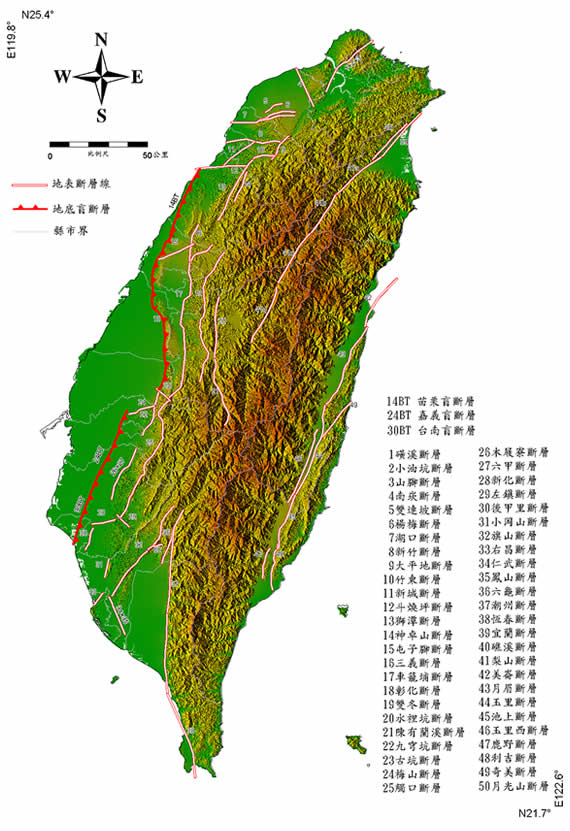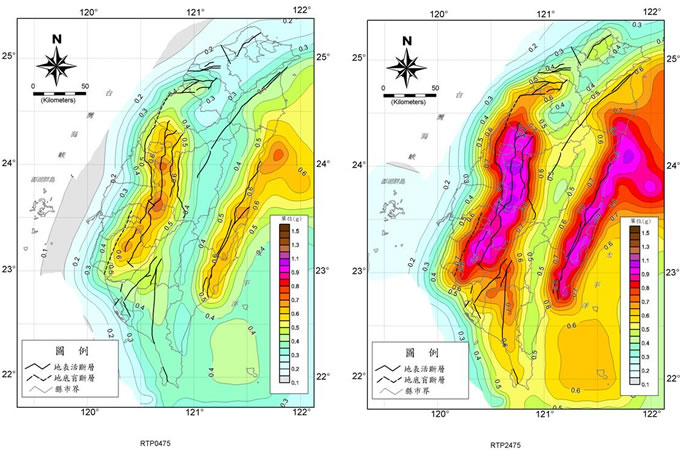|
摘要
本研究參考目前美國著名研究機構(如美國地調所USGS、太平洋地震工程研究中心PEER、美國陸軍工兵團U.S. Army Corps of Engineers)最先進之機率式地震危害度分析(PSHA)方法,進行台灣地區PSHA分析參數之本土化與方法研究。首先以地理資訊系統(GIS)輔助進行台灣地區之震源參數特性(活動斷層、地球物理、地質構造、地震機制)本土化工作,並建立台灣地區主要地震之強地動資料庫(TNGA),最後開發PSHA分析程式(SINO-PSHA)以及人工合成地震分析程式(SINO-RSPM),透過國內工程之地震評估案例,進行本計畫研發各程式之本土化驗證工作,以具體改善國內傳統之PSHA方法。
本研究改善傳統PSHA分析參數可分以下幾方面說明,在震源模式方面,除了傳統的區域震源外,另外以三維面震源模型模擬活斷層與隱沒帶板塊震源;在地震規模機率分布的推估方面,採用台灣地區1900年至1999年地震矩規模(MW)的獨立主震目錄,建立各區域震源的截切指數模式,並以各活斷層的滑移速率(S)資料建構特徵地震模式;在強地動衰減式方面,將震源分為地殼內部與隱沒帶兩類,並區分不同類地盤的測站,並依集集大地震之經驗,考慮斷層上盤及下盤測站的強地動差異與採用測站距斷層面最短距離。
研究結果顯示,以本計畫研發之PSHA程式(SINO-PSHA)進行工址地震評估時,確實可反映活動斷層位態分布與活動度對地震危害度之影響,因其採用邏輯樹方法故可獲知PSHA分析參數之不確定性,另透過參數解構成果分析,可瞭解區域各震源之主要震源危害度貢獻,後續參數解構更可應用於地震災害境況模擬。另外,SINO-RSPM程式進行人工合成地震製作時,確實可模擬出符合機率意義且擬似真實地震的地震歷時,可使後續動態分析成果較為合理。
關鍵詞: 地震危害度分析、強地動衰減式、機率式地震危害度分析
Abstract
The state of the art for probabilistic seismic hazard analsysis (PSHA) has been well developed in several research institutions (such as USGS, PEER, and U.S. Army Corps of Engineers). Based on their recent reseaches, the parameters and the computer codes of PSHA have been developed within study. Not only the information of geophysic, geology, seismology, and focal mechanisim for PSHA were integrated in Geographic Information System (GIS), but also the web-based ground motion database of major earthquakes in Taiwan was establisted. According to the site-dependent database, two computer codes were developed in this study. One is SINO-PSHA for PSHA and the other is SINO-RSPM for artificial seismograpm generation. The programs have been applied to the several projects, and thus to improved the PSHA methodology of the previous study herein.
Comparing to the previous PSHA, the improvement of the parameters implemented in SINO-PSHA can be summarized as following (1) 3-D plate source was adoped to model fault planes and subduction zone plates. (2) Truncated-Exponential model developed by mainshock catalog in MW from 1900 to 1999 was used to describe the magnitude distribution of regional sources, and Characteristic-Earthquake model developed by fault-slip rate was used to describe the magnitude distribution of active faults and subduction interface sources. (3) The ground-motion levels of subduction plate sources are always higher than crustal sources in PSHA. (4) Attenuation relationship of curustal source includes the ground-motion data of Chi-Chi earthquake sequence, and which shows the diferences between hanging-wall and foot-wall effects.
While using SINO-PSHA for seismic hazard assessment in case studies, the results show that the seismic hazard levels affected by the pattern distribution and the activities of active faults can be obtained. The parameter uncertainties can be obationed by logic tree method and contribution of seismic hazard level of focus can be determined by parameter deaggregation which can also be applied to hazard mitigation of scenario earthquake in future work. Futhermore, SINO-RSPM can generate the time history by matching the uniform hazard response spectrum in time domain. The simulated the time history which reflects the characteristics of probability and agree well with actual seismogram can be applied reasonably to seismic dynamic analysis.
Keywords: Seismic hazard analysis, Ground-motion attenuation model, PSHA
|




















